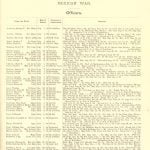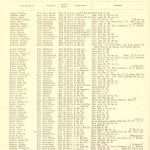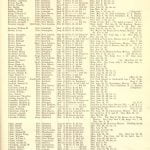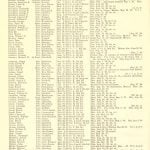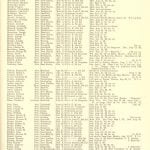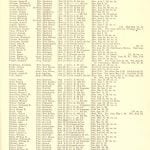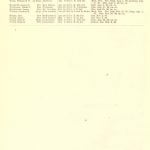On this page you will find an extensive listing of American military records found online for personal, genealogy and professional researchers; this list includes much free and searchable data. Because the military, being the archetype of bureaucratic organizations, has kept detailed records, these records are an invaluable source of information about servicemen and women and the families they may have left behind. Aside from the additional information to family stories, consider what these records represent in the history of the world.
- Indian Wars 1614-1893
The Indian Wars were a series of conflicts that occurred between Native American tribes and European colonizers in North America. These wars lasted for over two centuries and involved various battles and negotiations that were fought over land, resources, and political power. - Pequot Indian War, 1634-1638
The Pequot Indian War was a conflict between the Pequot tribe and English colonists in Connecticut. The war began after the Pequot tribe attacked a trading post and escalated into a larger conflict that resulted in the massacre of hundreds of Native Americans and the enslavement of others. - King Philip’s War Records, 1675-1676
King Philip’s War was a conflict between Native American tribes and English colonists in New England. The war was fought over land and resources and resulted in the death of thousands of Native Americans and colonists, as well as the forced migration of Native American tribes.- History of King Philip’s War
- King Philip’s War – Indian Wars
- King William’s War, 1689-1697
King William’s War was a conflict between English colonists and French settlers in North America. The war was fought over territory and resources and resulted in a significant loss of life and property damage on both sides. - Seminole Indian Wars, 1717-1835-1842-1855-1858
The Seminole Indian Wars were a series of conflicts between Native American tribes in Florida and the United States government. The wars were fought over land and political power and resulted in the forced relocation of thousands of Native Americans. - French and Indian War, 1754-1763
The French and Indian War was a conflict between British and French forces in North America. The war was fought over territory and resources and resulted in significant territorial changes, including the transfer of French territories in Canada to British control. - Dunmore’s War, 1774
Dunmore’s War was a conflict between Virginia settlers and Native American tribes in the Ohio Valley. The war was fought over land and resources and resulted in the defeat of the Native American tribes. - Revolutionary War, 1775-1783
The Revolutionary War was fought between American colonies and British forces over political and economic independence. The war resulted in the formation of the United States of America and a significant shift in global power. - Creek Indian Wars, 1811-1814-1842
The Creek Indian Wars were a series of conflicts between Native American tribes in the southeastern United States and the United States government. The wars were fought over land and resources and resulted in the forced relocation of thousands of Native Americans. - War of 1812, 1812-1814
The War of 1812 was a conflict between the United States and Great Britain over economic and territorial disputes. The war resulted in a significant loss of life and property damage on both sides. - Blackhawk War, 1832
The Blackhawk War was a conflict between Native American tribes in Illinois and Wisconsin and the United States government. The war was fought over land and resources and resulted in the forced relocation of thousands of Native Americans. - Republic of Texas, 1835-1846
Republic of Texas war was a conflict between the Republic of Texas and Mexico over political and economic independence. The war resulted in the annexation of Texas by the United States. - US Mexican War, 1846-1848
The US Mexican War was a conflict between the United States and Mexico over political and territorial disputes. The war resulted in significant territorial changes, including the acquisition of California and other western territories by the United States. - Sioux Indian Wars, 1854 – 1890
The Sioux Indian Wars were a series of conflicts between Native American tribes in the Great Plains region and the United States government. The wars were fought over land and resources and resulted in the forced relocation of thousands of Native Americans. - Civil War Records, 1861-1865
The Civil War was fought between the northern and southern states of the United States over political and economic differences, including the issue of slavery. The war resulted in the reunification of the United States and significant social and political changes. - Spanish American War, 1898-1902
The Spanish American War was a conflict between the United States and Spain over political and territorial disputes in the Caribbean and Pacific. The war resulted in the defeat of the Spanish and the acquisition of Puerto Rico, Guam, and the Philippines by the United States. - World War I, 1914-1919
World War I was a global conflict that began with the assassination of Archduke Franz Ferdinand of Austria-Hungary and resulted in the deaths of millions of people. The war involved multiple world powers and resulted in significant social, political, and economic changes, including the dissolution of the Austro-Hungarian and Ottoman Empires and the formation of the League of Nations. - World War II, 1935-1945 (US entered 1941)
World War II was a global conflict that began with the invasion of Poland by Germany and resulted in the deaths of tens of millions of people. The war involved multiple world powers and resulted in significant social, political, and economic changes, including the formation of the United Nations, the establishment of the United States and the Soviet Union as superpowers, and the devastation of much of Europe and Asia. - Korean Conflict, 1950-1953
The Korean Conflict was a war between North Korea (supported by the Soviet Union and China) and South Korea (supported by the United States and other allies) that began after North Korea invaded South Korea. The war resulted in a ceasefire and the establishment of a demilitarized zone between the two countries, but no formal peace treaty has been signed to this day. - Vietnam War Casualty List, 1961-1969
The Vietnam War was a conflict between North Vietnam (supported by the Soviet Union and China) and South Vietnam (supported by the United States and other allies) that began as a civil war and escalated into a larger conflict. The war resulted in significant loss of life and property damage and ended with the withdrawal of U.S. troops and the unification of North and South Vietnam. - Military Cemeteries
Recent Military Records
The following posts have references to military records or people who served in the military.
History of the Aroostook War, 1839
Record of Connecticut Men in the War of 1812
Record of Connecticut men who served in the Regular Army and the Militia in the War of 1812 compiled from rosters on file in Adjutant-General’s Office, Washington D. C. by authority of the general assembly Record of Connecticut Militia in the War of 1812 compiled from rosters on file in Adjutant-General’s Office, Washington D. C. Abbreviations Record of Connecticut Militia in the War of 1812 Record of Connecticut Men in the Regular Army, War of 1812 Officers Enlisted Men
Record of Service of Connecticut Men in the War of the Revolution
The several rolls and lists in the following pages have been arranged chronologically according to the description of the service in which the troops engaged. Thus, after the first alarm, the Continental soldiers are classified in the order in which they were called out, then the State troops, and finally the Militia, with special lists following. Index to Record of Revolutionary Service Index to Military History – Battles, Camps, Orders The Lexington Alarm The first lists in the record, grouped under the head of the “Out-break of the War,” include the names of the men who, under the provocation of…
Record of Connecticut Men in the Mexican War
Record of Connecticut men who served in the Regular Army during the Mexican War compiled from rosters on file in Adjutant-General’s Office, Washington D. C. by authority of the general assembly
Collections of the Connecticut Historical Society
Biographical Sketches of Distingushed Officers of the Army and Navy
Important Men of the Choctaw Indians
The Choctaw Nation, from its earliest known history to the present time has, at different intervals, produced many great and good men; who, had they have had the advantages of education, would have lived upon the pages of history equally with those of earth’s illustrious great. The first of whom we have any historical account, is Tush-ka Lu-sa, (the heroic defender of Moma Bin-na, a Lodge for All corrupted first to Mobila, then to Mobile) who perished, with many thousands of his people, in that bloody tragedy of three and a half centuries ago, while de fending his ancient city against…
Memoirs of the LeFlore Family
The Cravat families of Choctaws are the descendants of John Cravat, a Frenchman, who came among the Choctaws at an early day, and was adopted among them by marriage. He had two daughters by his Choctaw wife, Nancy and Rebecca, both of whom became the wives of Louis LeFlore. His Choctaw wife dying he married a Chickasaw woman, by whom he had four sons, Thomas, Jefferson, William and Charles, and one daughter, Elsie, who married- a white man by the name of Daniel Harris, and who became the parents of Col. J. D. Harris, whose first wife was Catharine Nail, the…
Biographical Sketch of Moses Davis
The records in the U. S. Pension Office show that Mr. Davis married Sarah Sawyer, at Dracut, Mass., April 6, 1785. He came to Hanover, New Hampshire, in 1806 or ’07, and from there to Norwich in 1813 or ’14. He was a soldier at the Battle of Lexington and it is supposed that he was in the Battle of Bunker Hill. In 1777 he served at Fishkill on the Hudson and the next year at Valley Forge. He was one of the guards over the spy, Major Andre, one or two nights before he was executed. The aggregate of…
Cushman Family of Norwich Vermont
The Cushman family in New England dates from the year 1621, the first after the landing of the Pilgrims from the Mayflower, when Robert Cushman, who was a prominent leader and organizer of the Plymouth Colony, brought from England the earliest recruits and supplies to the wasted and famishing settlement. A century and a half later Solomon Cushman, a descendant of Robert, in the sixth generation, born at Plympton, Mass., in 1745, having married Sarah Curtis, daughter of Simeon Curtis, at Lebanon, Conn., in 1768, removed to Norwich, probably in company with the Curtis family. Solomon Cushman (afterward known as…

